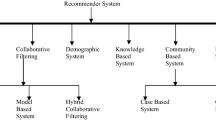Abstract
We discuss learning a profile of user interests for recommending information sources such as Web pages or news articles. We describe the types of information available to determine whether to recommend a particular page to a particular user. This information includes the content of the page, the ratings of the user on other pages and the contents of these pages, the ratings given to that page by other users and the ratings of these other users on other pages and demographic information about users. We describe how each type of information may be used individually and then discuss an approach to combining recommendations from multiple sources. We illustrate each approach and the combined approach in the context of recommending restaurants.
Similar content being viewed by others
References
Ali, K. and Pazzani, M. (1996). Error Reduction through Learning Multiple Descriptions. Machine Learning 24(3).
Balabanovic, M. (1997). An Adaptive Web Page Recommendation Service. First International Conference on Autonomous Agents. CA: Marina del Rey.
Balabanovic, M. and Shoham, Y. (1997). Fab: Content-Based, Collaborative Recommendation. Communications of the ACM 40(3), March 97.
Billsus, D. and Pazzani, M. (1998). Learning Collaborative Information Filters. In Shavlik, J. (ed.), Machine Learning: Proceedings of the Fifteenth International Conference. San Francisco, CA: Morgan Kaufmann Publishers.
Blum, A. (1997). Empirical Support for Winnow and Weighted-Majority Based Algorithms: Results on a Calendar Scheduling Domain. Machine Learning 26: 5-23.
Blum, A., Hellerstein, L. and Littlestone, N. (1995). Learning in the Presence of Finitely or Infinitely Many Irrelevant Attributes. Journal of Computer and System Sciences 50(1): 32-40.
Deerwester, S., Dumais, S. T., Furnas, G. W., Landauer, T. K. and Harshman, R. (1990). Indexing by Latent Semantic Analysis. Journal of the American Society for Information Science 41: 391-407.
Freund, Y., Iyer, R., Schapire, R. and Singer, Y. (1988). An Efficient Boosting Algorithm for Combining Preferences. In Shavlik, J. (ed.), Machine Learning: Proceedings of the Fifteenth International Conference. San Francisco, CA: Morgan Kaufmann Publishers.
Hull, D., Pedersen, J. and Schütze, H. (1996). Method Combination for Document Filtering. Proceedings of the 19th International Conference on Research and Development in Information Retrieval, 279-287. Switzerland: Zurich.
Kivinen, J. and Warmuth, M. (1995). Exponential Gradient Versus Gradient Descent for Linear Predictors. Information and Computation 132(1): 1-63.
Krulwich, B. (1997). LIFESTYLE FINDER: Intelligent User Profiling Using Large-Scale Demographic Data. Artificial Intelligence Magazine 18(2): 37-45.
Lang, K. (1995). NewsWeeder: Learning to Filter News. Proceedings of the Twelfth International Conference on Machine Learning. CA: Lake Tahoe.
Larkey, L. and Croft, B. (1996). Combining Classifiers in Text Categorization in Proceedings of the 19th International Conference on Research and Development in Information Retrieval, 289-297. Switzerland: Zurich.
Lewis, D., Schapire, R., Callan, J. and Papka, R. (1996). Training Algorithms for Linear Text Classifiers. In Hans-Peter Frei, Donna Harman, Peter Schauble and Ross Wilkinson (eds.), SIGIR '96: Proceedings of the 19th Annual International ACM SIGIR Conference on Research and Development in Information Retrieval, 298-306.
Lieberman, H. (1995). Letizia: An Agent that Assists Web Browsing. Proceedings of the International Joint Conference on Artificial Intelligence. Montreal.
Littlestone, N. and Warmuth, M. (1994). The Weighted Majority Algorithm. Information and Computation 108(2): 212-261.
Maes, P. (1994). Agents that Reduce Work and Information Overload. Communications of the ACM 37(7): 31-40.
Miller, G. (1991). WordNet: An On-line Lexical Database. International Journal of Lexicography 3(4).
Pazzani, M. and Billsus, D. (1997). Learning and Revising User Profiles: The Identification of Interesting Web Sites. Machine Learning 27: 313-331.
Press, W., Flannery, B., Teukolsky, S. and Vetterling, W. (1990). Numerical Recipes in C. Cambridge University Press.
Quinlan, J. R. (1986). Induction of Decision Trees. Machine Learning 1: 81-106.
Resnick, P., Iacovou, N., Suchak, M., Bergstrom, P. and Riedl, J. (1994). GroupLens: An Open Architecture for Collaborative Filtering of Netnews. Proceedings of Conference on Computer Supported Cooperative Work (CSCW'94), 175-186. Chapel Hill, NC: ACM Press.
Rocchio, J. (1971). Relevance Feedback Information Retrieval. In Gerald Salton (ed.), The SMART Retrieval System-Experiments in Automated Document Processing, 313-323. Englewood Cliffs, NJ: Prentice-Hall.
Rumelhart, D., Hinton, G. and Williams, R. (1986). Learning Internal Representations by Error Propagation. In Rumelhart, D. and McClelland, J. (eds.), Parallel Distributed Processing: Explorations in the Microstructure of Cognition. Volume 1: Foundations, 318-362. Cambridge, MA: MIT Press.
Salton, G. (1989). Automatic Text Processing. Addison-Wesley.
Salton, G. and Buckley, C. (1990). Improving Retrieval Performance by Relevance Feedback. Journal of the American Society for Information Science 41: 288-297.
Shardanand, U. and Maes, P. (1995). Social Information Filtering: Algorithms for Automating “Word of Mouth”. Proceedings of the Conference on Human Factors in Computing Systems (CHI'95), 210-217. Denver, CO: ACM.
Author information
Authors and Affiliations
Rights and permissions
About this article
Cite this article
Pazzani, M.J. A Framework for Collaborative, Content-Based and Demographic Filtering. Artificial Intelligence Review 13, 393–408 (1999). https://doi.org/10.1023/A:1006544522159
Issue Date:
DOI: https://doi.org/10.1023/A:1006544522159




